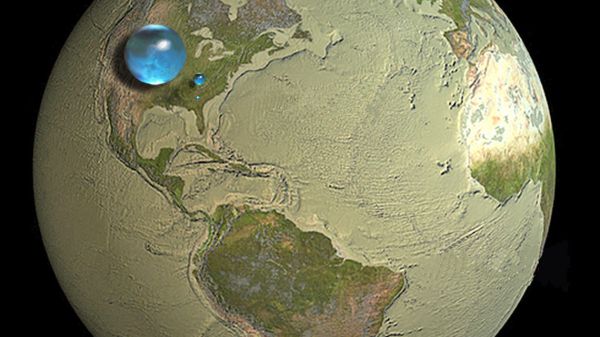All of Earth's Water in a single sphere

Spheres representing all of Earth's water, Earth's liquid fresh water, and water in lakes and rivers
The largest sphere represents all of Earth's water. Its diameter is about 860 miles (the distance from Salt Lake City, Utah, to Topeka, Kansas) and has a volume of about 332,500,000 cubic miles (mi3) (1,386,000,000 cubic kilometers (km3)). This sphere includes all of the water in the oceans, ice caps, lakes, rivers, groundwater, atmospheric water, and even the water in you, your dog, and your tomato plant.
Liquid fresh water
How much of the total water is fresh water, which people and many other life forms need to survive? The blue sphere over Kentucky represents the world's liquid fresh water (groundwater, lakes, swamp water, and rivers). The volume comes to about 2,551,100 mi3 (10,633,450 km3), of which 99 percent is groundwater, much of which is not accessible to humans. The diameter of this sphere is about 169.5 miles (272.8 kilometers).
Water in lakes and rivers
Do you notice the "tiny" bubble over Atlanta, Georgia? That one represents fresh water in all the lakes and rivers on the planet. Most of the water people and life of earth need every day comes from these surface-water sources. The volume of this sphere is about 22,339 mi3 (93,113 km3). The diameter of this sphere is about 34.9 miles (56.2 kilometers). Yes, Lake Michigan looks way bigger than this sphere, but you have to try to imagine a bubble almost 35 miles high—whereas the average depth of Lake Michigan is less than 300 feet (91 meters).
► Find out more:
How much water is there on Earth?
Where is Earth's water?
The water cycle
Details
Image Dimensions: 2520 x 3200
Date Taken: TUESDAY, JULY 16, 2019
Location Taken: US
Credits
Howard Perlman, Hydrologist, USGS, Jack Cook, Woods Hole Oceanographic Institution, Adam Nieman, Igor Shiklamonov
Source:
How much water is on Earth?






